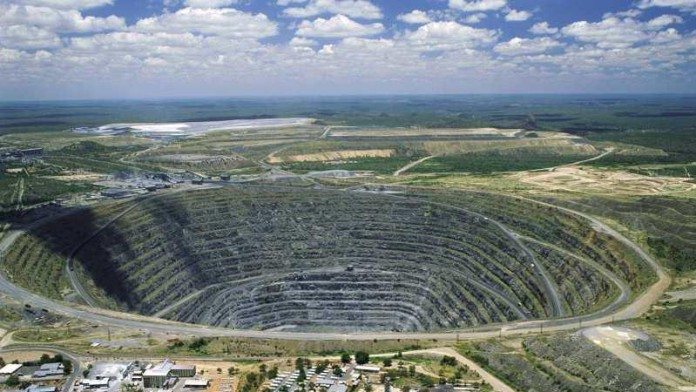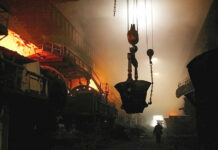
ONE of the first senior voices to dare suggest the seemingly interminable slump in the minerals and metals markets was nearing an end was Tom Albanese.
Ironically, it was Albanese who was the one of the market’s high profile casualties when in 2013 he resigned as CEO of Rio Tinto following $14bn in asset impairments, in part related to the firm’s headlong participation in top-of-the-market deal-making.
In April, as CEO of Vedanta Resources, Albanese said the metals market had bottomed out. “I believe what we’ve witnessed early in 2016 will be the trough for the commodity markets,” he said.
“Commodity prices have improved materially in the last couple of months, and investor sentiment has started to turn cautiously positive on the resources sector.”
It was a view that raised the eyebrows of his successor at Rio Tinto, Sam Walsh. “It is far more volatile than we’ve experienced in the past,” said Walsh who retired from Rio Tinto on July 1. “In that environment, calling the bottom is a brave move. It will turn though, as this is a cyclical industry,” he added.
Looking back on his comments several months ago, Albanese is surprised they received such global attention, saying that he was merely musing with investors during the question and answer session at Vedanta’s full-year results conference call. He also modified his optimism with conditions.
“I had put two caveats in there at that time and I would say they’re still important: one would be the direction of the US dollar, and the second will be as long as we don’t see any negative surprises coming out of the Chinese economy,” he said. “So it’s those two big macro features which are going to basically affect commodity sentiment over all.”
Commodity prices since the beginning of the year have improved significantly, especially iron ore, whilst there were gains in copper and nickel. Some price improvements are thought to have legs, such as in zinc where real supply constraints exist; the future of other metal prices remain tenuous; again, iron ore.
One of the commodity optimists is Paul Gait, an analyst for Bernstein. Pointing to improvements in the Chinese property market, and holding the view that 2015 was China’s hard landing – not a ‘new normal’ – he said the industry was in the early stages of a recovery.
“As such, the decline in metal demand seen in 2015 was not part of the ‘new normal’ but was rather the consequence of deliberate policy-tightening designed to eliminate some of the excesses of previous policy choices,” said Gait in a research note.
Supporting his contention that China’s property market was recovering, Gait said that growth in land purchased for construction had rebounded to its highest level since the start of 2015. “Area under construction growth has increased to the highest level since April 2015, and floor space of new starts growth has turned (strongly) positive for the first time since 2013,” he said.
The optimism is not a widely shared, however.
Mark Cutifani, CEO of Anglo American, doesn’t think there’s been a fundamental change in the direction of the market, not yet anyhow. “I’m not yet convinced that it’s as positive as people say. We may be at the bottom; we’ve probably seen the bottom, and we’re still closer to the bottom than people are saying.
“My concern still is that China is fragile. The property market has probably run quicker than the Chinese government expected and that tells me there are speculators in there priming. The iron ore recovery was encouraging, but still a bit of a feint. I don’t see robust demand yet,” he said.
“The US is again talking interest rates so we started to see commodities come off. So I have long held the view that I think 2016 will be a bumpy year and I’ve seen nothing as yet to deter us from the course we’re on.”
SELF HELP WORKING
Shares in mining companies have run aggressively, especially on the Johannesburg Stock Exchange where the depreciation of the rand against the dollar in December has given investors extra incentive to own them again.
And although macro-economic factors are largely behind this, there are positive signs that so-called ‘self-help’ measures conducted by companies, including cost-cutting and debt reduction – partly through dilutory share issues – are gaining traction.
“Companies are tidying up their balance sheets and therefore some projects have become available for sale,” said Roger Dixon, a consulting engineer for SRK in Johannesburg. “The strategies are to reduce costs although this has involved getting rid of technical people and that causes havoc with company morale,” he said.
Nonetheless, the turnaround in fortunes is notable.
In a note wittily titled, ‘We interrupt this rally to bring you … fundamentals’, Deutsche Bank said: “17 of the 19 companies under our coverage are now producing free cash flow after dividends in 2017,” said Deutsche Bank in a report earlier this year.
The Chinese government … has got lots of levers, and it is pulling them
“Free cash flow yields average 10% for the big four diversified miners, and 8.4% for the whole sector next year,” it said. “Gearing is also reducing: we forecast a drop from 26% in 2015 to 22% in 2016 and 16% in 2017,” it added.
In fact, so effective has been the cost-cutting that there’s recognition that future improvements to the industry cost base will only be marginal.
Speaking at the Bank of American Merrill Lynch 2016 Metals, Mining & Steel conference, BHP Billiton CEO, Andrew Mackenzie, said he had been surprised by the extent to which the mining sector had cut costs through productivity over the past three years.
The sector was “”… approaching the limits of what is possible given geological, geographical and skill constaints,” he said. “For many, if not all, the next step will be harder to take and will become an even greater differentiator into the future,” said Mackenzie.
BHP Billiton had achieved $10bn in annualised productivity gains over five years, he said. It had also introduced better efficiencies in its capital allocation processes, reducing capital expenditure 70% over the period.
“I remember sitting in my hotel room three years ago agonising over if I could commit to $15bn in capital expenditure a year,” said Mackenzie. “But next year, we will spend no more than $5bn. It is amazing what is possible when you put your mind to things,” he added.
“Our overheads are down more than 50% so we’ve made some pretty significant in-roads in our overheads right across the group including in South Africa,” said Anglo’s Cutifani. “If you look at just Kumba, it’s been pretty dramatic but we had to in order to survive,” he said.
Others think mining shares are due for a heavy correction. In its note on the future of commodities, Deutsche Bank said the re-rating in mining shares this year reflected a rotation by investors into sectors that benefited from economic turns such as the weaker dollar.
“The rally to date reflects a rotation into sector benefiting from a weaker US dollar, Chinese stimulus and the oil price rebound more than it reflects the slowly improving fundamentals – and we think each of these positives is now priced in,” it said.
As for the commodity markets in general, analysts are confident of improvements but cautious to say it’ll be this year. The run up in commodity prices so far was firmly related to short-term developments in the Chinese economy.
Said Kieran Daly, an analyst for UBS: “The Chinese government is prepared to do whatever it takes to keep its economy growing at a certain rate. It has got lots of levers, and it is pulling them”. And when the marktets do recover, he sees a return to the price levels that preceded the decade long supercycle of 2001 to 2011.
“I battle to see that we will have another demand driven supercycle, and I battle to see another significant demand event like we had in China,” he said.
“People talk about India as another China, but it is a very different proposition. People talk about Africa, but Africa is a collection of different countries and hard to see a significant growth story,” he said.
Said Tim Clark, an analyst for Standard Equities in Johannesburg: “We have seen an enormous run on the back of higher prices coming through, but our economists believe there is too much debt in China and they think they’ll be a slowdown; maybe not the hard landing that we have seen previously, but there will be declines in demand”.
“The depth of previous correction may be a little too deep this time around, but Chinese demand will wane,” he said.
PLATINUM
Platinum shares in Johannesburg have staged a huge recovery but analysts are at a loss to explain it since the prospects for platinum group metal prices are not likely to improve significantly this year.
Writing in March, Citi analyst Johann Steyn said downward pressure on platinum and its sister metals palladium and rhodium would reassert itself before long owing to some long-term structural issues in the industry that have formed over a period of years.
One factor is the growth in above ground stocks which the World Platinum Investment Council estimated stood at 2.32 million ounces at the end of 2015. Another is growth in autocatalyst recycling which supplies about 18% of demand as well as supply growth. South African platinum miners may be economically constrained but technically there is over capacity, he said.
In the medium to long-term, however, the outlook is actually good, according to Piet Viljoen, chairman of asset management firm, Re:CM, and CFO of Sibanye Resources’ platinum division, Justin Froneman, formerly an analyst.
“We are fundamentally bullish [on PGMs] otherwise we wouldn’t have committed R8bn on acquisitions and with probably more to come,” said Froneman of Sibanye’s capture of Rustenburg Platinum Mines from Anglo American Platinum and Aquarius Platinum.
“The key thing is getting through the headwinds,” he said, adding that rand prices for PGMs were likely to be flat for the next 18 to 24 months. About 50% of the platinum sector remained loss-making after capital expenditure, he said.
“PGMs probably show the most promise,” said Viljoen. “We think that supply will drop off quite sharply and with emission targets sharpened over time, demand will increase. The sector shows quite a lot of value,” he said.











